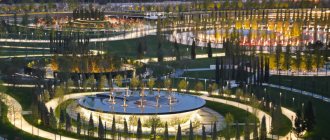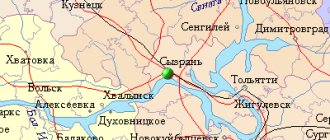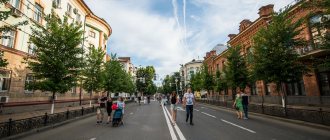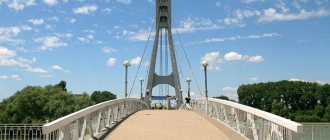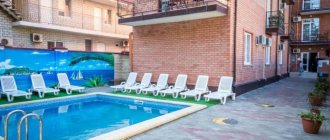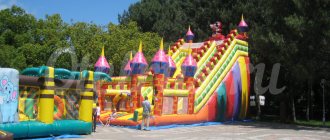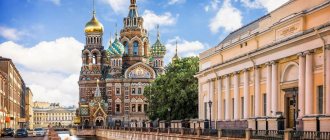Although Krasnodar cannot boast of thousand-year-old temples and ancient fortresses, travelers enjoy coming to this sunny and hospitable city. Monuments and museums, restaurants and amusement parks - there are places here both for lovers of cultural recreation and for those tourists who prefer active entertainment.
History of Krasnodar
closely connected with the history of the royal family.
Before the advent of Soviet power, it was called Ekaterinodar. The city was truly a “gift” from Catherine II - in 1792, the empress gave vast lands in the south to the Cossack army as a token of gratitude for their faithful service. And already in 1793, the Cossacks founded a military camp, which over time would turn into the huge capital of Kuban. When the Civil War began, Ekaterinodar
became the main stronghold of the White Army in the south of the country.
View of evening Krasnodar
Today, the main city of Kuban is gradually turning into a modern metropolis. In 1-2 days
It’s impossible to visit all the sights, but a walking tour will help you feel the friendly spirit of the city and let you get in touch with the history of the Russian south.
Kissing Bridge
The elegant openwork bridge, the image of which appears on many posters, postcards and calendars, is one of the symbols of modern Krasnodar. On its railings you can always see many locks with names engraved. These are symbols of love, harmony and fidelity. According to established tradition, local newlyweds and simply loving couples leave them here. Next to the Bridge of Kisses there is a pier from where you can take a romantic trip around the Kuban on pleasure boats. The crossing also plays the role of an observation deck: from here you will see a picturesque panorama of the entire city, and from the nearby restaurant there are magnificent views of the bridge itself and the beautiful nearby park. The original building and the surrounding landscape look especially good in the evening and at night, when the decorative lanterns are lit.
Historical Buildings
Moorish house
Address: st. Pushkina, 61
The mansion was built in 1910 in memory of the love between the architect and the Georgian princess. The girl was taken to Georgia, where she died of longing for her beloved, and the young engineer put all his love into the architectural structure.
Today, there are 15 apartments inside the building - the families living in it are in no way connected with the former owner. Local residents, inspired by the history of the architectural building, call it the “Mansion of Love.”
Ivan Rymarevich-Altmansky is a loving engineer-architect whose personal life never worked out. In 1920, Rymarevich, being alien to politics, came under repression, and nothing further is known about the fate of the brilliant architect. Only the Moorish house, the brainchild of an engineer in love, reminds of his talent. The Moorish House is part of the East in modern Krasnodar.
Kissing Bridge
Address: st. Kubanskaya embankment, 37/10
An engineering structure that unites the hearts of lovers is a sought-after place for the youth of Krasnodar. It is here that after the wedding ceremony, the newlyweds seal their feelings with a kiss and lock them away from prying eyes.
The bridge is a romantic place for lovers and connoisseurs of natural landscapes, views of the Kuban River, and the evening embankment in lights. The cable-stayed bridge was built and opened on May 9, 2003. A pedestrian bridge connects the city's park area with the populated area.
Bogarsukov's mansion
Address: st. Gimnazicheskaya, 67
The richest merchants of Yekaterinodar of Armenian origin, the Bogarsukov brothers, knew how to stand out with luxury and eloquence. Developing cultural life in the city, they built a luxurious house where they held charity concerts, Christmas tree celebrations, balls and performances.
The two-story mansion in the historical part of the city was built at the beginning of the 20th century and was intended as a house for the brothers Christopher and Karp to live with their families. But due to political and military events in Russia, the architectural building began to belong to the country of the Soviets. The brothers went abroad, leaving the destroyed country.
The secret of the mansion to this day is the unknown name of the author of the project for the family nest of merchants. Later, the building alternately housed the headquarters of General A.I. Denikin, the city department of the NKVD, and since 1960 the house was occupied by the historical and archaeological museum named after Evgeniy Dmitrievich Felitsyn - more about it is written below.
Estate of the merchant Rubezhansky
Address: st. Kommunarov, 8
The history of this estate goes back to 1908. Vasily Rubezhansky is a Russian landowner, a famous and honorary citizen of Yekaterinodar, in the past a simple master furniture maker built an estate for his family. The merchant’s occupation was not only the production of furniture, he was the first to introduce the townspeople to cinematography.
The property that the merchant was building cost him 125 thousand rubles in gold. In 1920, after the restoration of Soviet power in Kuban, Vasily Kondratyevich Rubezhansky, becoming a victim of the “Red Terror,” was arrested and executed. The family was evicted from their home and handed over to the Chamber of Commerce and Industry.
Today it houses the offices of the Chamber of Commerce and a children's library.
Monument to Catherine II
Address: Catherine Square (between Pushkin, Krasnaya and Postovaya streets)
At the beginning of the twentieth century, a majestic monument to the empress, who gave the lands of Kuban to the Black Sea Cossacks, was erected in Krasnodar. For Yekaterinodar, the monument became the main symbol.
But with the Bolsheviks coming to power, the situation changed - the city was renamed, and its symbol was demolished in 1920 (and later melted down).
After the collapse of the USSR, the residents of Krasnodar decided to return the monument to the city, and in 2006 a new monument was inaugurated in the center of Catherine Park. It exactly replicates the destroyed monument and is again one of the symbols of Krasnodar.
Red Street
This beautiful street in the center of Krasnodar is one of the favorite vacation spots for both local residents and city guests. There are many theaters and museums, cafes and shops, beautiful buildings with exquisite architecture and historical monuments, which include the Military Cathedral of the Holy Blessed Prince Alexander Nevsky and the Triumphal Arch of Alexandria (Royal Gate). All travelers should definitely go to this street in Krasnodar to stroll along the plane tree alley and other picturesque green areas with bright flower beds and ornamental shrubs, admire the musical fountains beautifully illuminated in the evening, see the flower clock and the famous monument to Shurik and Lidochka, and have an amazing taste delicious pastries at the Patrick and Marie bakery. Art lovers can visit the Art Museum located here. F. A. Kovalenko and the Central Concert Hall of the Kuban Cossack Choir. During the holidays, Red Street always hosts concerts, fairs and other exciting events. During this time, traffic is blocked and the street becomes completely pedestrian.
Monasteries and churches
St. Catherine's Cathedral
Address: st. Kommunarov, 52 Phone: Website: kubansobor.ru Opening hours: Mon. sub. — 07:00–19:00, Sun — 06:00–20:00 Entry cost: free
The cathedral was erected in honor of the deliverance from the death of the family of Tsar Alexander III, who visited Ekaterinodar. Returning to Moscow, the royal train suffered a terrible disaster, where Alexander’s wife and sons miraculously survived. On March 24, 1914, the consecration of the temple, erected in the city and named in honor of the patron saint of Krasnodar, St. Catherine the Great Martyr, took place.
By 1914, the interior work was completed, and the temple itself was consecrated. However, after 3 years, a difficult time began for Russia, and after the Bolsheviks established themselves in Krasnodar, the cathedral began to be taken away. By the 1930s it was closed completely, and a warehouse was opened in the building. The temple was generally going to be demolished, but the chief architect of the building (and former chief architect of Krasnodar) Malgerb convinced the commission not to destroy the building.
Temple of Alexander Nevsky
Address: st. Guardhouse. 26 Phone: Website: alexander-nevskiysobor.ru Opening hours: daily 07:00–19:00 Entrance fee: free
The first stone church in Krasnodar. The date of its consecration is 1872. The cathedral was honored with a visit from Tsar Alexander III and his sons Nicholas and George. The design of the cathedral was carried out by the brothers architects Ivan and Elisha Cherniky. The cathedral was decorated by outstanding architects of that time - Fyodor Rubtsov and Fyodor Zhuravlev.
For the Kuban Cossacks, the cathedral served as a repository for relics and regalia of the Cossack army. In addition to ancient church books, royal charters and military banners have been preserved here.
There has always been a choir at the temple; today it is the famous Kuban Cossack Choir.
After the complete demolition of the cathedral in 1932, it was restored in 2006 thanks to the efforts shown and funds raised by the public. The shrines of the temple are the ark with the relics of Prince Alexander Nevsky, the icon of the Kazan Mother of God, the ark with the relics of St. Dmitry of Rostov, Job of Pochaev, and Andrei Bogolyubsky.
St. George's Church
Address: st. Mitrofana Sedina, 170 Phone: Website: st-george.ru Opening hours: daily from 07:00–19:00 Entrance fee: free
The predecessor of the cathedral was a monastery. The consecration of the temple in the name of St. George the Victorious is dated November 30, 1903.
According to legend, there was a Greek settlement on the territory of what is now the Krasnodar Territory. The Greeks who went out to sea were caught in a strong storm. The sailors prayed for mercy, and St. George the Victorious appeared to them, after which the storm subsided. The rescued and grateful sailors built a monastery in honor of their savior.
And already at the founding of Ekaterinodar, on the site of a monastery destroyed by time, a temple to St. George the Victorious was erected. The project was carried out by Ivan Malgerb, the architect of St. Catherine’s Cathedral.
The Orthodox shrine of the city preserves the relics of such great saints as John of Riga, Barbara the Martyr, John Chrysostom and the Great Martyr George the Victorious.
St. Elias Church
Address: st. Pashkovskaya, 47 Telephone: , telephone number of the priest on duty. Daily from 10.00 to 18.00 Website: hram-ilya.ru/ Opening hours: daily from 7:00 to 20:00 Entry cost: free
In the 90s of the 19th century, a cholera epidemic raged on the territory of the modern Krasnodar Territory. Losses among the population amounted to more than 15 thousand people. Having organized a nationwide prayer service on the day of the Holy Prophet Elijah, the residents of Ekaterinodar gave their word to build a temple in the name of the saint if the disease subsided. Cholera left, the temple was erected and consecrated on May 25, 1907.
The site for construction was given free of charge by sisters-philanthropists Roshchina and Minaeva as gratitude for saving the city’s population. Donations were made for the construction of the temple not only by rich residents of the city, but also by ordinary people. All the people were grateful to the patron of natural disasters.
In 1954, at the request of the regional executive committee, the temple was subject to demolition. But by the will of fate, the document was lost in the folders of capital officials, and the church remained untouched. Today the temple is a religious heritage of Krasnodar.
Holy Trinity Cathedral
Address: st. Frunze, 65 Phone: (861) 259-30-02 Website : https://kubantrinity.orthodoxy.ru/ Opening hours: from 7:00 to 19:00 daily
Many local residents consider the Trinity Cathedral to be the most beautiful building in the city. It was built in honor of the miraculous rescue of the royal family, heading to Krasnodar (the train had an accident, but no one was injured). This happened in 1888, and a year later the decision was made to build a temple. However, it was consecrated only in 1910.
The author of the building was again the architect Malgerb (the author of St. Catherine's Cathedral and St. George's Church). During Soviet times, this temple was also closed, and in its place there was first a warehouse, and then a sculpture workshop. The temple was reopened only in 1990, at which time work began on restoring the facade and interior decoration (all the paintings in the cathedral were covered over).
Now the Holy Trinity Cathedral is working, conducting rituals and services. The large colorful iconostasis looks impressive inside.
Galitsky Park in Krasnodar
Despite its youth, the park, opened in 2021, is very popular among lovers of both active and relaxing holidays. The modern infrastructure brought to perfection and the unique design evoke positive emotions among the most discerning guests, and the careful thought out of each element of the improvement makes it possible to accommodate a huge number of visitors in a small area without the slightest damage to their comfort. The most visited places in the park are a spacious amphitheater, often used for cultural events and photo sessions, an observation deck with a spiral lift, a skate park popular with young people, a children's climbing wall, and a water maze with LED fountains.
Fountain of Krasnodar
Near the amazingly beautiful musical fountain on Teatralnaya Square it is always lively and fun. There is never a shortage of spectators here: the jets shimmering in different colors attract attention at any time of the day. During the day they sparkle in the sun, and at dusk they become the main participants in an enchanting light show, accompanied by mesmerizing melodies: changing shape and intertwining, the jets create the most incredible compositions with the help of modern computer technology. The largest fountain in Europe is deservedly a source of pride for Krasnodar residents and one of the most striking brands of the city. It is no coincidence that it became the center of many festive events.
theatre square
Thanks to the beautiful complex of fountains, Teatralnaya Square in Krasnodar has become a favorite walking area for city residents, especially in the summer heat. It is located next to the M. Gorky Drama Theater, in honor of which it received its name. In total, there are more than twenty fountains in the square. The square is notable for the fact that it is there that the largest flat fountain-concert is installed - jets of water rise to the height of a five-story building accompanied by classical music, while the fountain is decorated with multi-colored lighting. In the dark, this spectacle simply takes your breath away. To admire the fountain, you need to arrive in the city during its operating period - from April to November. You can also see nearby a memorial obelisk, which was installed on the square in honor of the celebration of the bicentenary of the Kuban Cossack army. In addition, there are cafes and benches nearby where you can relax.
Kuban embankment in Krasnodar
A beautiful green embankment with decorative lanterns and elegantly decorated lawns, stretching along the wide Kuban, is one of those places worth visiting in Krasnodar. Ideal conditions have been created here for people of all ages to relax. The walking area, thoroughly landscaped after recent reconstruction, is equipped with comfortable benches, neat slopes and observation platforms. Mothers with strollers stroll along picturesque pedestrian paths, children frolic on attractions, pensioners relax in gazebos, and outdoor enthusiasts visit swimming pools and sports grounds. On the embankment there are many famous sights of Krasnodar: the Kissing Bridge - a favorite place for newlyweds, the 30th Anniversary of Victory Park, where rare exhibits from war times are collected, the Turgenev Automobile Bridge with original graffiti and beautiful night illumination.
What to see depending on the time of year
Krasnodar is located between the southern seas and a cool continent, and is characterized by sharp weather changes, but the climate here is mild continental. Summers in Krasnodar are long and hot, and winters are short and mild. The average temperature in winter is from +6.5 °C to -13 °C. The snow in Krasnodar is unstable. Therefore, you can relax here at any time of the year. Of course, if you need resort conditions, it is better to come in the summer. In addition, Krasnodar also has seasonal attractions, such as water parks.
Waterpark Niagara
Niagara is an outdoor summer water park opening in 2021. The water park has many water attractions (slides, pools, slopes, etc.). For the convenience of guests, there are changing rooms, areas with sun loungers, showers and a cafe. There are separate “shallow” pools for children. Foam parties are held at night. During the operation of the water park, lifeguards are on duty.
Everything you need for relaxation (slippers, towels, etc.) can be purchased in a special area of the water park
Information for visitors:
Retro Car Museum
A unique exhibition dedicated to the history of cars will remain in the memory for a long time for those who decide to go to the famous Museum of Retro Cars in Krasnodar. Here you can see luxurious foreign convertibles from the early 20th century, as well as examples of legendary Soviet brands that can no longer be seen on modern streets: Pobeda, Volga, Zhiguli, Niva, Moskvich. Many of the unique exhibits are still in working order. The feeling of the atmosphere of the past is enhanced with the help of old thematic photographs, newspapers and stills from films that cover the walls of the museum, rare telephones and cameras, and record players that have long disappeared from everyday life.
Where is the city
Krasnodar is located in the southern part of our country on the banks of the river. Kuban. It is the central settlement of the Krasnodar Territory. The distance to Moscow is 1.3 thousand km, to the Black Sea – 120 km, and to the Azov Sea – 140 km.
The city has excellent transport links with other parts of the country.
You can get here in various ways:
- By plane. International and domestic flights arrive at the airport. Catherine II, located 20 km from the center of Krasnodar. The maximum number of airliners flies here from Moscow. Travel time – 2 hours 20 minutes. But regular communication connects the capital of Kuban with almost all major cities of our country. From the airport to Krasnodar you can take minibus No. 7 or a trolleybus with the same number.
- By train. There are as many as 2 railway stations in Krasnodar, which connect 5 railway directions. The bulk of passenger trains are passing trains heading to the Black Sea resorts. The minimum travel time from Moscow is 18 hours 20 minutes.
- By bus. Bus service connects Krasnodar with many cities of the region, neighboring regions, as well as with the capital. The journey from Moscow takes about 17 hours.
- By car. Several highways pass through the capital of Kuban, the most popular of which is the M4 highway, connecting Moscow and Novorossiysk. The route between Moscow and Krasnodar can be covered in approximately 15.5 hours.
Thus, Krasnodar has a favorable geographical location and is a major transport hub.
Sunny Island Park
This 39-hectare green area is one of the best places to take spectacular photographs against the backdrop of beautiful scenery. The vast territory, where Krasnodar residents love to spend their leisure time, contains many entertainment facilities and quiet corners of nature for secluded relaxation. On the river bank you can rent a catamaran, and in the rope park you can test your dexterity and endurance. In addition to numerous sports grounds, an indoor ice skating rink and a network of attractions, there are such popular attractions as the Safari Park and the Planetarium. On holidays, the sounds of popular musical compositions performed by famous artists can be heard from the park's grounds.
Safari park in Krasnodar
One of the most popular places in Krasnodar is home to hundreds of species of animals from different parts of the world, including those listed in the Red Book. The conditions for keeping fauna representatives living in spacious enclosures are as close as possible to their natural habitat. The Safari Park organizers took care of the comfort of not only the animals, but also the guests. There are cafes and playgrounds for them, and thematic competitions are regularly held. Zoo visitors have the opportunity to watch the life of wild animals and exotic birds, feed the inhabitants from their own hands and become spectators in the local pinniped theater, which demonstrate their extraordinary acting talents three times a day.
City Garden
Those who are not indifferent to the beauty of nature should definitely go to the City Garden in Krasnodar. This green oasis has occupied its place of honor on the city map since the mid-19th century. Nowadays, the City Garden is a landscaped park with well-groomed flower beds, beautiful fountains and neat paths. Guests will be interested in visiting the dolphinarium located here, taking pictures against the backdrop of a natural monument - a six-hundred-year-old oak tree, admiring the graceful swans swimming in the pond, and taking a ride on the second tallest Ferris wheel in Russia. After visiting all the sights, you can enjoy relaxing in the shade of the trees.
Interesting places to relax with children
Families with children also don’t have to worry about interesting and varied leisure time. The city has many children's clubs, entertainment centers and other facilities.
Ocean Park Aquarium
Address: Krasnodar, st. Uralskaya 98/11.
The Krasnodar Oceanarium is located in the Galaktika shopping mall and occupies an area of more than 3 thousand m². Here you can observe the life of 200 species of fish, reptiles and amphibians also live.
In addition, the following events are held here:
- open feeding of sharks, moray eels and piranhas;
- show with sharks and piranhas.
The entertainment facility is open every day from 10.00 to 22.00. The cost of an adult ticket is 550 rubles. For children from 4 to 13 years old inclusive you will have to pay 400 rubles. Children under 4 years old are admitted free of charge.
Circus
Address: Krasnodar, st. Rashpilevskaya 147.
The circus building appeared in Krasnodar in 1970. It is a classic round-shaped structure, designed by the Institute of Sports Facilities. It was precisely such buildings that appeared in many large cities during Soviet times.
The circus program includes performances by gymnasts, magicians, illusionists, trainers, acrobats, and clowns. The circus box office is open every day from 10.00 to 19.00. The cost of tickets depends on the category of seats and ranges from 600 rubles. up to 1.5 thousand rubles. Children under 5 years old can attend the performances for free.
Thus, in Krasnodar you can visit many interesting places. Here everyone will find fascinating objects: history buffs, those wishing to enjoy a relaxing holiday, and families with children.
Monument to Shurik and Lidochka
Bronze figures of the well-known characters from Gaidai’s film can be seen in the city center, on Krasnaya Street. The monument is installed opposite one of the largest universities in Krasnodar - Kuban Technological University. The location was not chosen by chance: exemplary students are called upon to set a good example for current students. The sculpture is made in human height so that everyone can make sure that the girl is reading the notes, just like in the film. The attraction is very popular among tourists: every guest of the city considers it necessary to capture himself in a photo in the company of the famous couple in love.
Let's go to the center: routes and prices
It is better to explore the sights of Krasnodar starting from the center.
Path from the airport
The distance from Pashkovsky Airport to the center is 12 km. You have 2 options: order a taxi or use public transport.
Private traders are waiting for clients near the airport. There is no clear tariff; it all depends on the ability to bargain. You can also order an accredited taxi at the counter in the airport building or go online and make an order online. The last option is the most budget-friendly. The cost is known in advance and starts from 350 rubles. and higher.
The most accessible transport is city transport. To get to the center, you need to get to the Krasnodar-1 railway station (not to be confused with the second station) and make a transfer. The journey will take about 1 hour. Choose minibus No. 53 or trolleybus No. 7. The fare is the same: 28 rubles.
Path from the railway or bus station
The route in both cases is the same, because The bus station building is located a 5-minute walk from the railway station on the station square. Choose bus No. 2E, trolleybus No. 2 or 8, minibus No. 20, 53 or 9. Be prepared for the fact that you will have to pay an additional 28 rubles for bulky luggage.
Path by car
The shortest and fastest route from the railway station to Krasnaya Street passes through Levanevsky and Budyonny Streets. The distance is just over 3 km.
Krasnodar Planetarium
The Krasnodar Planetarium is located in a spherical building, giving it a resemblance to a celestial dome. Popular science films are regularly shown in its hall, telling in an accessible and interesting way about everything related to space: planets and their satellites, stars, the Universe, the solar system and much more. The use of a modern projection system and high-quality acoustics of the hall enhance the impression of the audience, creating the effect of being in outer space. Educational films on natural science school subjects, dedicated to the laws of development of the surrounding world, are also no less visual and educational. The planetarium has a telescope for observing celestial bodies.
Where to dine in the center: cuisine, average bill and reviews
On Krasnaya, everyone will find a place where they have delicious food and quality service. The cafes in Krasnodar serve dishes from different cuisines. Since there is a lot of competition, establishment owners try to attract customers by creating a cozy and unusual atmosphere.
Bumbarash
This is the most colorful restaurant in Krasnodar. Authentic design and excellent Georgian cuisine attract visitors. The menu includes kutabs, shish kebab, kharcho, and wine. On Fridays, guests can listen to the singing of Georgian vocalists. Even the waiters dance to the fiery rhythms. Reviews about “Bumbarash” are the most enthusiastic. Average check: 500 rub. Address: st. Krasnaya, 143/3, site.
Fritteria Pythagoras
The Pythagoras Fritteria recently opened in an unusual pyramid-shaped building. The menu includes Belgian potatoes, churros, and Black Sea seafood popcorn. Guests like the unusual exterior and fast service. Average check: 300 rub. Address: st. Krasnaya, 111/1, Instagram.
Coral beads
The menu of the Coral Beads restaurant contains recipes from all over the world. In summer, guests can sit on the terrace and enjoy city views from the panoramic rooftop. Next to the restaurant there are “Singing Fountains”, which is especially popular among visitors. Average check: 450 rub. Address: st. Krasnaya, 169/1, website, Instagram.
Ballerina and Beefsteak
The establishment is called a cultural event in the life of the capital of Kuban. The menu offers a selection of steaks in different varieties. In addition, you can find unusual dishes. For example, Ural posikunchiki. Average check: 500 rub. Address: st. Krasnaya, 40, website, Instagram.
Krasnodar Regional Art Museum
The rich collection of one of the oldest museums in the North Caucasus, founded by the famous collector F. A. Kovalenko at the beginning of the 20th century, consists of Russian and Western European works of painting, decorative and applied arts, sculpture, and graphics. A significant part of the exhibition is devoted to icon painting, Russian avant-garde of the 20-30s of the last century, Russian landscape painting, and Japanese woodcuts. Interactive materials created for visitors tell in a visual and entertaining way about the contents of the fund and the main stages of the history of the Krasnodar Regional Art Museum. Using modern equipment, virtual exhibitions are regularly held.
Krasnodar Historical and Archaeological Museum
In 1879, Kuban historian and local historian E.D. Felitsyn founded the Military Ethnographic and Natural History Museum, the fund of which served as the basis for the creation of the Krasnodar Historical and Archaeological Museum in the 30s of the last century. Its rich fund is famous for its unique collections of ancient coins, jewelry, Polovtsian sculptures, ancient Greek ceramics, and weapons. One of the activities of the museum is underwater archaeological expeditions, which make a huge contribution to the development of historical science. Anyone interested in the way of life, customs and culture of the peoples of Russia and the Caucasus should definitely visit this place in Krasnodar.
Krasnodar Academic Drama Theater
One of the largest theaters in Kuban has been very popular among spectators for more than 100 years. Before the revolution of 1917, F. Chaliapin, L. Sobinov, and A. Duncan performed triumphantly on the stage of the theater, then called the Winter Theater. The first play produced in Soviet times was “The Bourgeois” based on the play by Gorky, whose name the theater bears from 1932 to this day. The group's modern repertoire consists of productions of the best examples of the dramatic genre from different countries and times, including fairy tales for children. The theater stage always successfully hosts enterprises and concerts of famous Russian artists.
Philharmonic
The City Philharmonic named after Grigory Ponomarenko is a magnificent concert hall that hosts concerts of a wide variety of genres. The beautiful Philharmonic building, which was erected in 1909, is an architectural monument and is located in the very heart of the city, at the intersection of Krasnaya and Gogol streets. Residents of Krasnodar are proud both of the building itself, built in a classical architectural style, and of the repertoire presented there. It was at the Philharmonic that a new name was given to the city. During its existence, the building has seen many famous speakers, among whom were V. Mayakovsky, A. Duncan, I. Severyaninov.
St. Catherine's Cathedral in Krasnodar
The fate of the famous St. Catherine's Cathedral cannot be called simple. Construction of the majestic temple building with five domes began in 1900, but the consecration took place only 14 years later. The walls of the cathedral were painted by famous icon painters, and the interior was distinguished by rich decoration. During the Soviet years, many valuables were removed from the walls of the church. Soon after this, the cathedral was closed, and a warehouse was placed in its building. The temple reopened during the Great Patriotic War, after the liberation of Krasnodar from occupation. For the celebration of the 1000th anniversary of the Baptism of Rus', it was completely restored. Today, a charitable foundation operates in St. Catherine's Cathedral. Pilgrims from many cities come to the shrines of the temple.
You have already voted
History of the creation and renaming of the city, characteristics
Ekaterinodar, whose sights have existed for several thousand years, was founded as a military camp with a fortress on the banks of the Kuban River by the Black Sea Cossacks in 1793, when Empress Catherine II granted them these southern lands as eternal possession for victories in the Russian-Turkish war.
The settlement grew quite quickly, first due to the construction of wooden houses, and later from bricks, which were made and fired right next to each other in 2 kilns built.
In the 60th year of the 19th century it was already an administrative center, and after another 7 years it was given the status of a city. With the advent of the railway, the city turned into a major transport and trade center in the region. Merchants are already settling here, various workshops, a hospital, a gymnasium are appearing, and the first metalworking factories are being built.
By the beginning of the last century, 150 thousand people already lived in the city, and the number of plants and factories reached 125. The city did not accept the revolution, and during the civil war it was the center of the White Guard south of the country until the year 20. After the establishment of Soviet power, the city was renamed Krasnodar.
During the Great Patriotic War, the city had to endure the fascist occupation, which claimed the lives of more than 13 thousand citizens.
Today it is a large cultural and economically developed city covering an area of more than 330 square meters. km. Its length from north to south is more than 20 km, and from west to east about 30 km.
Climate
The city is located at 45 degrees north latitude near two warm seas, which has a favorable effect on its climatic conditions. A mild continental climate prevails here with hot, long, dry summers and mild, very short, moderately warm winters. Short-term frosts down to -15 or -20 degrees rarely occur. Snow is rare; most precipitation falls in the form of rain.
Ekaterinodar (Krasnodar) - maximum and minimum recorded temperature
Autumn is clear and warm by the beginning of October, and the number of cloudy days and precipitation gradually increases. In November, strong winds blow and frosts begin. Spring comes at the end of February, and in March the plants begin their active growing season.
Ecology
The main environmental problem in the city is severe air pollution from vehicle emissions, since there are more cars registered here per capita than in all Russian cities. In summer, due to the increase in transit transport of vacationers, the number of cars in the city increases to 2 million.
Population
The urban population is steadily increasing every year due to economic migrants and the resettlement of residents of the Far North, and has already reached almost 900 thousand people. There is also an increase in natural population growth due to the birth rate and a decrease in the mortality rate.
The city's population is very diverse in terms of ethnic composition:
| Nationality | Thousand people | Share % |
| Russians | 654,7 | 87,9 |
| Armenians | 26,9 | 3,6 |
| Ukrainians | 10,6 | 1,4 |
| Adygei | 6,9 | 0,9 |
| Belarusians | 2,1 | 0,3 |
| Tatars | 2,0 | 0,3 |
| Greeks | 1,6 | 0,2 |
| Georgians | 1,5 | 0,2 |
| Azerbaijanis | 1,4 | 0,2 |
| other | 14,1 | 1,9 |
Flora and fauna
The vegetation of the region is rich and diverse. There are more than 30 thousand plant species here. The dominant trees are deciduous, evergreen deciduous and coniferous. In addition to fruit and berry trees, pine trees, junipers and yews grow in the city.
Among the animals in the city and its environs, small mammals predominate: hedgehogs, squirrels, mice, hares, bats and rats, and on the outskirts, foxes and weasels. Among the birds found within the city limits are pigeons, seagulls, ducks, starlings, tits, sparrows, cormorants, swifts and nightingales. You can see a swan and a heron, and sometimes owls. Reptiles include turtles, snakes, lizards and vipers.
